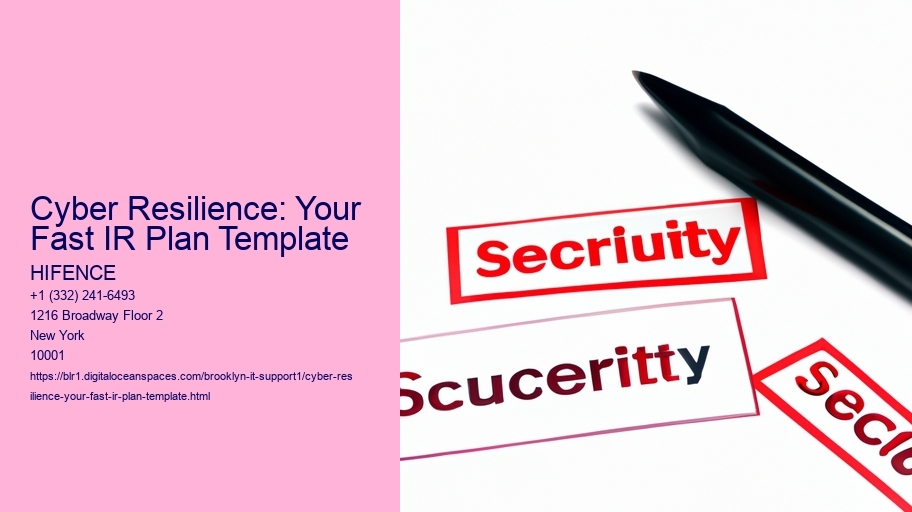
Cyber resilience, eh? incident response preparation . It aint just about blocking all the bad guys; its about bouncing back, kinda like a rubber ducky in a bathtub filled with digital gunk. Understanding cyber resilience means knowing that attacks will happen, its not a matter of if, but when. And when they do, ya gotta be ready.
Incident response, now thats the "what do we do now?" part. You cant just freeze like a deer in headlights. A fast IR plan template, thats yer friend. It shouldnt be complicated. Think checklist, not encyclopedia. Who to call, what systems to isolate, what evidence to preserve – stuff like that.
It doesnt mean youll never get hit, but it ensures you aint stuck paddling upstream without a paddle. A proper plan isnt just a document; its a living thing, updated regularly, practiced, and understood by everyone involved. Its not something you ignore until disaster strikes, or youll be sorry. Gosh, its like having a fire escape plan – you hope you never need it, but youre sure glad its there when the smoke starts rollin. managed service new york So get your IR plan together and dont delay!
Cyber Resilience: Your Fast IR Plan Template – Key Components

Okay, so cyber resilience aint just about never getting hacked, right? Its about bouncing back when, inevitably, something goes wrong. And that's where a solid, fast Incident Response (IR) plan template comes in super handy. You dont want to be scrambling, figuring it all out when youre already under attack, do ya?
The "fast" bit is crucial. Were talkin speed here. No dawdling. The longer an attack goes unchecked, the more damage it inflicts. So, what are the essential pieces of this plan? Well, you cant overlook clear roles and responsibilities. Someone needs to be in charge, and everyone else needs to know who that person is and what theyre supposed to do. Aint no room for confusion in a crisis.
Next, you mustnt neglect communication protocols.
Dont think you can skip threat intelligence either. Understanding potential threats and vulnerabilities is key to preparedness. What are your most likely attack vectors? What kind of data are you most at risk of losing? Knowing this helps you prioritize your responses and focus your resources where theyre needed most.

And finally, you shouldnt ignore the recovery process. I mean, the incident response isnt over until youve restored systems, patched vulnerabilities, and learned from the experience. This includes backup strategies, data recovery procedures, and post-incident analysis. Its not just about putting out the fire; its about preventing it from happening again! Gosh, it sounds like a lot, but a well-crafted template is the start of it all.
Okay, so you wanna, like, actually do something with that Cyber Resilience: Your Fast IR Plan Template, huh? Not just let it sit there, gathering digital dust. I get it. It can be daunting. But dont freak! This isnt rocket science. Think of this as a, well, step-by-step guide to using a step-by-step guide. How meta is that?
First, you absolutely mustnt skip past the initial assessment. I know, boring, right? But you cant build a house on sand, and you definitely cant defend your network without knowing what youre defending from. Were talking identifying your critical assets, understanding your vulnerabilities, and, ugh, threat modeling. It aint fun, but it sure is necessary.

Next, dont underestimate the power of clear communication. Who needs to be notified when the, you know, stuff hits the fan? And how? Spell it out! Dont assume everyone knows the plan. They probably dont. Create an incident response team, assign roles, and make sure everyone knows their responsibilities. Ignoring this is just asking for chaos.
Then theres containment and eradication. This is where things get messy. Follow the templates guidance on isolating affected systems, removing malware, and restoring data. Dont try to be a hero and do it all yourself, either. Thats a recipe for disaster.
And lastly, its not over once the fires out. Post-incident activity is crucial. Conduct a thorough review of what happened, identify what went wrong, and update your plan accordingly. Learn from your mistakes, and ensure that future attacks arent as effective. Skipping this is basically inviting trouble back for seconds.
So there you have it. A non-perfect, somewhat messy overview. It's not foolproof but a decent starting point. Good luck!

Oh, man, figuring out who does what when the cyber stuff hits the fan? Thats the "Roles and Responsibilities" part of your Incident Response plan, and its super important for cyber resilience. You cant not have clearly defined roles. Imagine a fire drill where nobody knows where to go or what to do! Yeah, chaos.
So, this section isnt just a list of job titles; its about specifying who is responsible for what during an incident. You gotta delegate, right? Someones gotta be the Incident Commander, the one calling the shots, making the hard choices. And you sure dont want them handling the technical details at the same time! Thats, like, impossible.
Then you need a team. Technical experts, obviously; people who can dig into the infected systems, patch vulnerabilities, and contain the damage. You also need someone handling communications, both internally (telling employees whats happening, calming nerves) and externally (talking to customers, law enforcement, maybe even the media, ugh). You cant gloss over legal aspects either, someone needs to know about data breach notifications and potential liabilities.

Dont underestimate the importance of clear documentation. Somebody must keep a log of everything that happens. What was seen, when, what actions were taken, and by whom. If you forget, youll have a hard time learning from it. In short, roles and responsibilities is not a section you can ignore if you want to bounce back effectively after a cyberattack. Its your roadmap through the digital storm, and without it, youre just adrift.
Cyber resilience isnt just about not getting hacked; its about how quickly you bounce back when, inevitably, you do. And a fast incident response (IR) plan? Thats your lifeline. But a plan alone aint gonna save ya; you need the right tools and tech. So, what are the essentials?
First off, dont underestimate the power of a decent SIEM (Security Information and Event Management) system. You cant fight what you cant see, and a SIEM helps you see everything - logs, alerts, network traffic – all in one place. It aint perfect, it needs tuning, but its your early warning system.
Next, think endpoint detection and response (EDR). This is your boots on the ground, detecting malicious activity happening on individual machines. They aint just for alerts; good EDR tools let you isolate infected systems, gather forensic data, and even remediate threats remotely.
Network traffic analysis (NTA) cant be ignored. managed services new york city Its like having a security camera on your network. You cant always rely on logs alone. NTA tools analyze network flows to spot anomalies, like unusual communication patterns or data exfiltration attempts.
Oh, and dont forget incident response platforms (IRP). managed services new york city Managing an incident is a chaotic process. IRPs help you automate tasks, track progress, collaborate with your team, and ensure youre following your plan. They arent a replacement for skilled responders, but they keep everyone on the same page.
Finally, dont overlook vulnerability management tools. Proactive scanning for weaknesses in your systems is crucial. You can't patch everything immediately, but knowing where your vulnerabilities are helps you prioritize your response efforts.
These tools arent magic bullets. check They require skilled operators, well-defined processes, and a commitment to continuous improvement. But, coupled with a solid IR plan, theyre your best bet for a rapid and effective response when the inevitable happens. Gosh, it really is a lifesaver!
Okay, so youve got a Cyber Resilience Incident Response (IR) plan, specifically that "Fast IR Plan Template." Great! But dont just think youre done. You absolutely must test and refine it. Seriously, like, yesterday-ish.
Thing is, a plan that looks good on paper aint worth beans if it crumbles under pressure. Imagine it: a real cyberattack is happening, alarms are blaring, and suddenly your teams discovering the "fast" plan is anything but fast. Maybe the contact list is outdated, or the steps are, well, not very clear. Or worse, it has sections that arent achievable. Yikes!
Testing, you see, will uncover those weaknesses. Tabletop exercises are an awesome start; run through different scenarios, see how the team reacts, and note any bottlenecks. Dont ignore those "what if" questions! Did anyone think about what happens if the primary incident commanders unavailable? What if the internets down? What then?
Refining your plan, based on that testing, is just as important. And it shouldnt be a one-time thing. managed services new york city Cyber threats evolve, your systems change, your team gains new skills. Your IR plan needs to keep up. Review it regularly, update it, and test it again. Think of it like this: its a living document, always improving.
Dont let a poorly tested plan be the reason you cant recover quickly from an incident. Thatd be a real bummer, right? So, get testing, get refining, and make sure your "Fast IR Plan Template" can actually do what it says it can. Youll thank yourself later!
Okay, so youve weathered the storm, yeah? Your Incident Response (IR) plan kicked in – maybe flawlessly, maybe not. But the smokes cleared.
Were talking about taking a hard, honest look at what didnt go according to plan. Did communication break down? Was there a tool that failed you? Did someone, heaven forbid, click on that phishy link despite training? Nows the time to figure it out, not point fingers, but understand why.
Neglecting this phase is like, well, ignoring a weird engine noise until your car just dies on the highway. Youre just setting yourself up for the same problems, perhaps even worse ones, down the road. And who wants that?
Its about creating a culture of continuous improvement. You arent looking for perfection; nobody expects that. Youre aiming for progress. Identify weaknesses, update your IR plan, retrain staff, and perhaps invest in better security tools. The key is to make sure youre learning from past mistakes so youre better prepared next time.
Furthermore, its not just about the technical stuff. Its also about the human element. How did the team handle the pressure? Were there any signs of burnout? Incident response can be stressful, and supporting your team emotionally is crucial.
The bottom line? Dont let a cyber incident go to waste. Extract every possible lesson, implement changes, and build a more resilient organization. Its an investment thatll pay off, trust me.